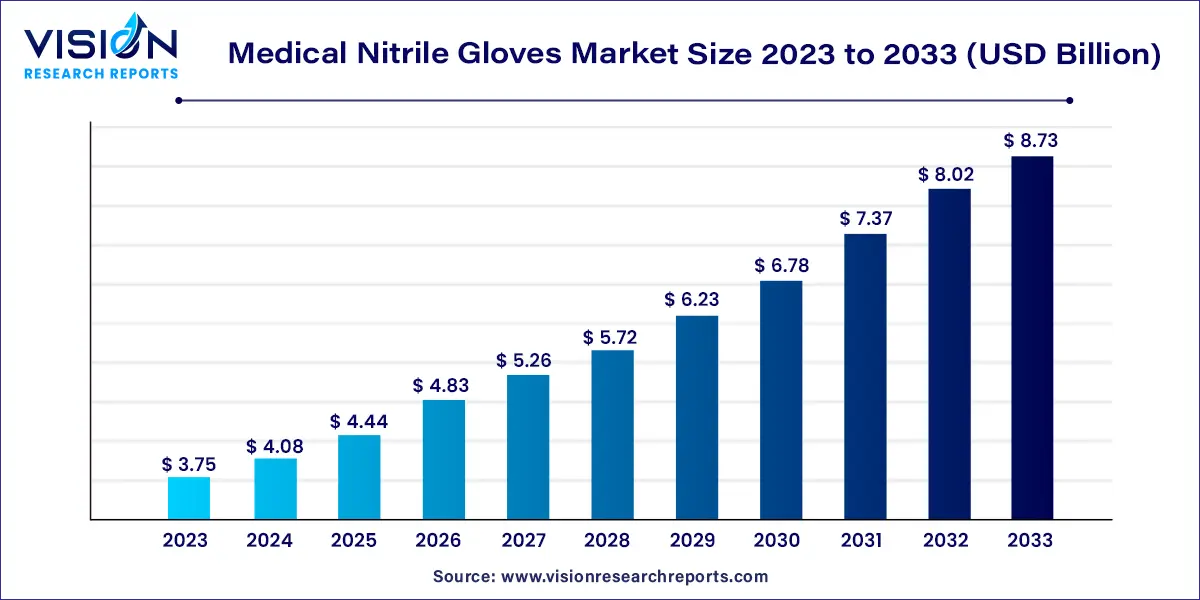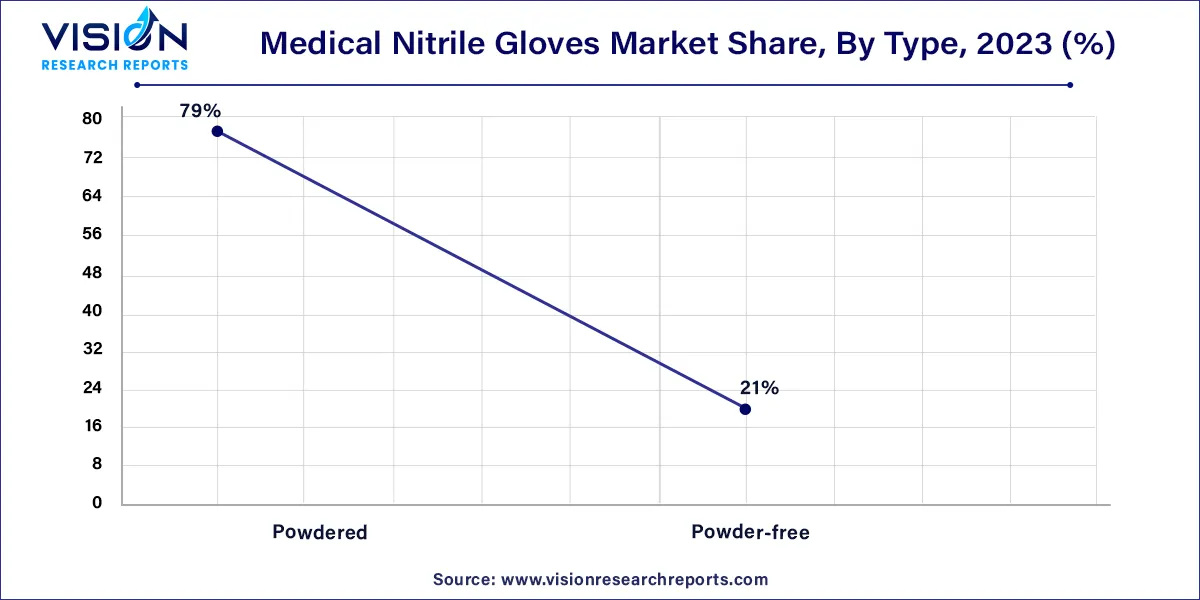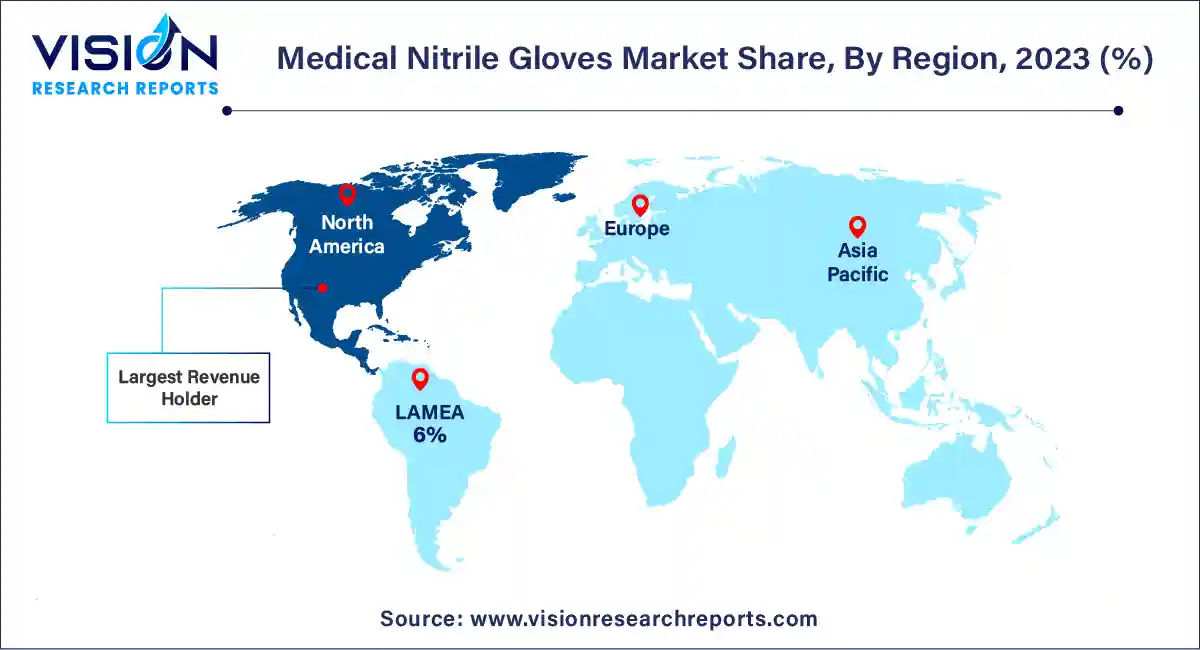The global medical nitrile gloves market size was estimated at around USD 3.75 billion in 2023 and it is projected to hit around USD 8.73 billion by 2033, growing at a CAGR of 8.82% from 2024 to 2033. The medical nitrile gloves market is driven by the increasing emphasis on hygiene and safety in the healthcare sector. Nitrile gloves have gained prominence as a preferred choice due to their durability, puncture resistance, and superior protection against various contaminants.

The growth of the medical nitrile gloves market is propelled by several key factors. Firstly, the heightened awareness of hygiene and safety measures within the healthcare sector, particularly in response to global health challenges, has significantly increased the demand for nitrile gloves. Moreover, stringent regulations governing personal protective equipment (PPE) have compelled healthcare facilities to prioritize the adoption of nitrile gloves, given their compliance with quality and safety standards. The continuous rise in global healthcare expenditure, especially in emerging economies, further contributes to the market's expansion, as healthcare institutions prioritize infection control measures.
The powdered variety emerged as the dominant segment, capturing a substantial 79% market share in 2023. This form facilitates the convenient donning and doffing of gloves, a crucial factor for professionals frequently changing gloves during their tasks. Notably, the healthcare sector stands out as a major consumer of this product, driven by the imperative need for PPE in hospitals, clinics, and various healthcare facilities.

Nevertheless, the chlorination process presents certain drawbacks, such as the potential for powder-free gloves to become more challenging to swiftly remove and a potential decrease in overall glove grip. In response to these challenges, manufacturers employ polymer coatings like acrylics, silicones, and hydrogels. These coatings introduce a lower surface friction than the glove material itself, facilitating an easier process for users to don and doff the gloves.
Disposable nitrile gloves are typically thinner than durable gloves, providing greater sensitivity. These gloves offer protection against mild chemicals and irritants, though they are not suitable for use with harsh chemicals or in demanding environments such as metal & manufacturing or oil & gas industries. Durable nitrile gloves, in contrast, boast higher chemical resistance compared to other disposable options. Designed for single-use and disposal after each use, disposable nitrile gloves provide safety assurance and cost-effectiveness, driving their demand in the foreseeable future.
Durable nitrile gloves are specifically engineered for challenging environments and are intended for multiple uses. They come with several advantages, including enhanced durability, strength, minimal waste generation, and other environmental benefits. Characterized by their thickness, which surpasses that of disposable nitrile gloves, they ensure prolonged use without tearing easily, providing heightened hand protection in demanding work settings. Despite their durability, these gloves are less sensitive than their disposable counterparts, potentially causing discomfort during intricate tasks. Additionally, they require more frequent cleaning after use, introducing an inconvenience compared to disposable gloves that can be easily discarded post-use.
Examination nitrile gloves find widespread use among healthcare professionals during routine physical examinations of patients. These gloves are instrumental in various activities, including checking vital signs, palpating specific areas, and conducting comprehensive health assessments. Their thin and tactile nature allows for detailed examinations without compromising sensitivity. In diagnostic settings, healthcare providers commonly utilize examination gloves when collecting samples or performing procedures that do not involve surgery, such as obtaining blood samples, conducting swab tests, or performing dermatological examinations.
On the other hand, surgical nitrile gloves play a crucial role in the operating room, where they are worn by surgeons and other members of the surgical team. Serving as a sterile barrier, these gloves prevent contamination during surgical interventions. The textured surface of surgical nitrile gloves enhances the surgeon's grip on delicate instruments, enabling precise movements during surgery—a critical aspect for maintaining control and minimizing the risk of errors. Furthermore, surgical gloves are indispensable for preserving a sterile environment in the operating room.
Medical nitrile gloves play a vital role in various diagnostic procedures, including drawing blood for laboratory tests, collecting samples for cultures, and conducting swab tests. Their usage serves to prevent direct contact between healthcare workers' hands and bodily fluids, effectively reducing the risk of infection transmission. Healthcare professionals, including doctors, nurses, and medical assistants, rely on medical nitrile gloves during routine patient examinations. These gloves establish a protective barrier, allowing healthcare workers to conduct physical examinations while minimizing the potential for cross-contamination. The increasing utilization of these gloves in home healthcare is fueled by a growing emphasis on personal protective measures and infection control within domestic settings.
With the rising demand for home healthcare services, driven by factors such as an aging population, the prevalence of chronic conditions, and a focus on patient comfort, the need for protective gear becomes paramount. Medical nitrile gloves offer a convenient and effective solution, enabling caregivers and individuals receiving care at home to maintain a barrier against potential infections. Whether during routine health monitoring, administering medications, or providing wound care, these gloves facilitate safe interactions, contributing to the overall well-being of patients and caregivers in the home healthcare environment.
In 2023, North America emerged as the dominant force in the global medical nitrile gloves market. The region exhibited a strong market presence, driven by heightened awareness of infection control, especially in the aftermath of the COVID-19 pandemic. This increased awareness has led to a greater emphasis on personal protective equipment (PPE), with medical nitrile gloves playing a pivotal role in the overall strategy. Factors contributing to this market dominance include the expansion of healthcare infrastructure, augmented healthcare spending, and the imperative for robust safety measures in medical facilities. Additionally, the prevalence of chronic diseases, an aging population, and an upswing in healthcare services have propelled the widespread adoption of nitrile gloves across various medical applications. The versatility, durability, and hypoallergenic properties of nitrile gloves position them as the preferred choice for healthcare professionals.

Simultaneously, the medical nitrile gloves market in the Asia Pacific region is poised for significant growth in the coming years. This growth is underpinned by factors such as the increasing demand for eco-friendly products, a rising consumption of medical gloves in Asian countries, and adherence to high safety standards. The demand for examination gloves is on the rise in Asia, finding applications in medical examinations, surgeries, chemotherapy, and other medical procedures. Notably, major market players are investing in sustainable and biodegradable glove production methods, aligning with environmental considerations and meeting evolving customer expectations.
By Type
By Product
By Application
By End-use
By Region
Chapter 1. Introduction
1.1. Research Objective
1.2. Scope of the Study
1.3. Definition
Chapter 2. Research Methodology
2.1. Research Approach
2.2. Data Sources
2.3. Assumptions & Limitations
Chapter 3. Executive Summary
3.1. Market Snapshot
Chapter 4. Market Variables and Scope
4.1. Introduction
4.2. Market Classification and Scope
4.3. Industry Value Chain Analysis
4.3.1. Raw Material Procurement Analysis
4.3.2. Sales and Distribution Channel Analysis
4.3.3. Downstream Buyer Analysis
Chapter 5. COVID 19 Impact on Medical Nitrile Gloves Market
5.1. COVID-19 Landscape: Medical Nitrile Gloves Industry Impact
5.2. COVID 19 - Impact Assessment for the Industry
5.3. COVID 19 Impact: Global Major Government Policy
5.4. Market Trends and Opportunities in the COVID-19 Landscape
Chapter 6. Market Dynamics Analysis and Trends
6.1. Market Dynamics
6.1.1. Market Drivers
6.1.2. Market Restraints
6.1.3. Market Opportunities
6.2. Porter’s Five Forces Analysis
6.2.1. Bargaining power of suppliers
6.2.2. Bargaining power of buyers
6.2.3. Threat of substitute
6.2.4. Threat of new entrants
6.2.5. Degree of competition
Chapter 7. Competitive Landscape
7.1.1. Company Market Share/Positioning Analysis
7.1.2. Key Strategies Adopted by Players
7.1.3. Vendor Landscape
7.1.3.1. List of Suppliers
7.1.3.2. List of Buyers
Chapter 8. Global Medical Nitrile Gloves Market, By Type
8.1. Medical Nitrile Gloves Market, by Type, 2024-2033
8.1.1. Powdered
8.1.1.1. Market Revenue and Forecast (2021-2033)
8.1.2. Powder-free
8.1.2.1. Market Revenue and Forecast (2021-2033)
Chapter 9. Global Medical Nitrile Gloves Market, By Product
9.1. Medical Nitrile Gloves Market, by Product, 2024-2033
9.1.1. Disposable
9.1.1.1. Market Revenue and Forecast (2021-2033)
9.1.2. Durable
9.1.2.1. Market Revenue and Forecast (2021-2033)
Chapter 10. Global Medical Nitrile Gloves Market, By Application
10.1. Medical Nitrile Gloves Market, by Application, 2024-2033
10.1.1. Examination
10.1.1.1. Market Revenue and Forecast (2021-2033)
10.1.2. Surgical
10.1.2.1. Market Revenue and Forecast (2021-2033)
Chapter 11. Global Medical Nitrile Gloves Market, By End-use
11.1. Medical Nitrile Gloves Market, by End-use, 2024-2033
11.1.1. Hospitals
11.1.1.1. Market Revenue and Forecast (2021-2033)
11.1.2. Home Healthcare
11.1.2.1. Market Revenue and Forecast (2021-2033)
11.1.3. Outpatient/Primary Care Facilities
11.1.3.1. Market Revenue and Forecast (2021-2033)
11.1.4. Others
11.1.4.1. Market Revenue and Forecast (2021-2033)
Chapter 12. Global Medical Nitrile Gloves Market, Regional Estimates and Trend Forecast
12.1. North America
12.1.1. Market Revenue and Forecast, by Type (2021-2033)
12.1.2. Market Revenue and Forecast, by Product (2021-2033)
12.1.3. Market Revenue and Forecast, by Application (2021-2033)
12.1.4. Market Revenue and Forecast, by End-use (2021-2033)
12.1.5. U.S.
12.1.5.1. Market Revenue and Forecast, by Type (2021-2033)
12.1.5.2. Market Revenue and Forecast, by Product (2021-2033)
12.1.5.3. Market Revenue and Forecast, by Application (2021-2033)
12.1.5.4. Market Revenue and Forecast, by End-use (2021-2033)
12.1.6. Rest of North America
12.1.6.1. Market Revenue and Forecast, by Type (2021-2033)
12.1.6.2. Market Revenue and Forecast, by Product (2021-2033)
12.1.6.3. Market Revenue and Forecast, by Application (2021-2033)
12.1.6.4. Market Revenue and Forecast, by End-use (2021-2033)
12.2. Europe
12.2.1. Market Revenue and Forecast, by Type (2021-2033)
12.2.2. Market Revenue and Forecast, by Product (2021-2033)
12.2.3. Market Revenue and Forecast, by Application (2021-2033)
12.2.4. Market Revenue and Forecast, by End-use (2021-2033)
12.2.5. UK
12.2.5.1. Market Revenue and Forecast, by Type (2021-2033)
12.2.5.2. Market Revenue and Forecast, by Product (2021-2033)
12.2.5.3. Market Revenue and Forecast, by Application (2021-2033)
12.2.5.4. Market Revenue and Forecast, by End-use (2021-2033)
12.2.6. Germany
12.2.6.1. Market Revenue and Forecast, by Type (2021-2033)
12.2.6.2. Market Revenue and Forecast, by Product (2021-2033)
12.2.6.3. Market Revenue and Forecast, by Application (2021-2033)
12.2.6.4. Market Revenue and Forecast, by End-use (2021-2033)
12.2.7. France
12.2.7.1. Market Revenue and Forecast, by Type (2021-2033)
12.2.7.2. Market Revenue and Forecast, by Product (2021-2033)
12.2.7.3. Market Revenue and Forecast, by Application (2021-2033)
12.2.7.4. Market Revenue and Forecast, by End-use (2021-2033)
12.2.8. Rest of Europe
12.2.8.1. Market Revenue and Forecast, by Type (2021-2033)
12.2.8.2. Market Revenue and Forecast, by Product (2021-2033)
12.2.8.3. Market Revenue and Forecast, by Application (2021-2033)
12.2.8.4. Market Revenue and Forecast, by End-use (2021-2033)
12.3. APAC
12.3.1. Market Revenue and Forecast, by Type (2021-2033)
12.3.2. Market Revenue and Forecast, by Product (2021-2033)
12.3.3. Market Revenue and Forecast, by Application (2021-2033)
12.3.4. Market Revenue and Forecast, by End-use (2021-2033)
12.3.5. India
12.3.5.1. Market Revenue and Forecast, by Type (2021-2033)
12.3.5.2. Market Revenue and Forecast, by Product (2021-2033)
12.3.5.3. Market Revenue and Forecast, by Application (2021-2033)
12.3.5.4. Market Revenue and Forecast, by End-use (2021-2033)
12.3.6. China
12.3.6.1. Market Revenue and Forecast, by Type (2021-2033)
12.3.6.2. Market Revenue and Forecast, by Product (2021-2033)
12.3.6.3. Market Revenue and Forecast, by Application (2021-2033)
12.3.6.4. Market Revenue and Forecast, by End-use (2021-2033)
12.3.7. Japan
12.3.7.1. Market Revenue and Forecast, by Type (2021-2033)
12.3.7.2. Market Revenue and Forecast, by Product (2021-2033)
12.3.7.3. Market Revenue and Forecast, by Application (2021-2033)
12.3.7.4. Market Revenue and Forecast, by End-use (2021-2033)
12.3.8. Rest of APAC
12.3.8.1. Market Revenue and Forecast, by Type (2021-2033)
12.3.8.2. Market Revenue and Forecast, by Product (2021-2033)
12.3.8.3. Market Revenue and Forecast, by Application (2021-2033)
12.3.8.4. Market Revenue and Forecast, by End-use (2021-2033)
12.4. MEA
12.4.1. Market Revenue and Forecast, by Type (2021-2033)
12.4.2. Market Revenue and Forecast, by Product (2021-2033)
12.4.3. Market Revenue and Forecast, by Application (2021-2033)
12.4.4. Market Revenue and Forecast, by End-use (2021-2033)
12.4.5. GCC
12.4.5.1. Market Revenue and Forecast, by Type (2021-2033)
12.4.5.2. Market Revenue and Forecast, by Product (2021-2033)
12.4.5.3. Market Revenue and Forecast, by Application (2021-2033)
12.4.5.4. Market Revenue and Forecast, by End-use (2021-2033)
12.4.6. North Africa
12.4.6.1. Market Revenue and Forecast, by Type (2021-2033)
12.4.6.2. Market Revenue and Forecast, by Product (2021-2033)
12.4.6.3. Market Revenue and Forecast, by Application (2021-2033)
12.4.6.4. Market Revenue and Forecast, by End-use (2021-2033)
12.4.7. South Africa
12.4.7.1. Market Revenue and Forecast, by Type (2021-2033)
12.4.7.2. Market Revenue and Forecast, by Product (2021-2033)
12.4.7.3. Market Revenue and Forecast, by Application (2021-2033)
12.4.7.4. Market Revenue and Forecast, by End-use (2021-2033)
12.4.8. Rest of MEA
12.4.8.1. Market Revenue and Forecast, by Type (2021-2033)
12.4.8.2. Market Revenue and Forecast, by Product (2021-2033)
12.4.8.3. Market Revenue and Forecast, by Application (2021-2033)
12.4.8.4. Market Revenue and Forecast, by End-use (2021-2033)
12.5. Latin America
12.5.1. Market Revenue and Forecast, by Type (2021-2033)
12.5.2. Market Revenue and Forecast, by Product (2021-2033)
12.5.3. Market Revenue and Forecast, by Application (2021-2033)
12.5.4. Market Revenue and Forecast, by End-use (2021-2033)
12.5.5. Brazil
12.5.5.1. Market Revenue and Forecast, by Type (2021-2033)
12.5.5.2. Market Revenue and Forecast, by Product (2021-2033)
12.5.5.3. Market Revenue and Forecast, by Application (2021-2033)
12.5.5.4. Market Revenue and Forecast, by End-use (2021-2033)
12.5.6. Rest of LATAM
12.5.6.1. Market Revenue and Forecast, by Type (2021-2033)
12.5.6.2. Market Revenue and Forecast, by Product (2021-2033)
12.5.6.3. Market Revenue and Forecast, by Application (2021-2033)
12.5.6.4. Market Revenue and Forecast, by End-use (2021-2033)
Chapter 13. Company Profiles
13.1. Ansell Ltd.
13.1.1. Company Overview
13.1.2. Product Offerings
13.1.3. Financial Performance
13.1.4. Recent Initiatives
13.2. Honeywell International, Inc.
13.2.1. Company Overview
13.2.2. Product Offerings
13.2.3. Financial Performance
13.2.4. Recent Initiatives
13.3. Top Glove Corporation Bhd
13.3.1. Company Overview
13.3.2. Product Offerings
13.3.3. Financial Performance
13.3.4. Recent Initiatives
13.4. Hartalega Holdings Berhad
13.4.1. Company Overview
13.4.2. Product Offerings
13.4.3. Financial Performance
13.4.4. Recent Initiatives
13.5. Kimberly-Clark
13.5.1. Company Overview
13.5.2. Product Offerings
13.5.3. Financial Performance
13.5.4. Recent Initiatives
13.6. Kossan Rubber Industries Bhd
13.6.1. Company Overview
13.6.2. Product Offerings
13.6.3. Financial Performance
13.6.4. Recent Initiatives
13.7. Superior Gloves
13.7.1. Company Overview
13.7.2. Product Offerings
13.7.3. Financial Performance
13.7.4. Recent Initiatives
13.8. MCR Safety
13.8.1. Company Overview
13.8.2. Product Offerings
13.8.3. Financial Performance
13.8.4. Recent Initiatives
13.9. Supermax Corporation Berhad
13.9.1. Company Overview
13.9.2. Product Offerings
13.9.3. Financial Performance
13.9.4. Recent Initiatives
13.10. Ammex Corporation
13.10.1. Company Overview
13.10.2. Product Offerings
13.10.3. Financial Performance
13.10.4. Recent Initiatives
Chapter 14. Research Methodology
14.1. Primary Research
14.2. Secondary Research
14.3. Assumptions
Chapter 15. Appendix
15.1. About Us
15.2. Glossary of Terms
 Cross-segment Market Size and Analysis for
Mentioned Segments
Cross-segment Market Size and Analysis for
Mentioned Segments
 Additional Company Profiles (Upto 5 With No Cost)
Additional Company Profiles (Upto 5 With No Cost)
 Additional Countries (Apart From Mentioned Countries)
Additional Countries (Apart From Mentioned Countries)
 Country/Region-specific Report
Country/Region-specific Report
 Go To Market Strategy
Go To Market Strategy
 Region Specific Market Dynamics
Region Specific Market Dynamics Region Level Market Share
Region Level Market Share Import Export Analysis
Import Export Analysis Production Analysis
Production Analysis Others
Others